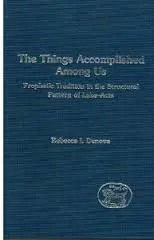

The Things Accomplished Among Us: Prophetic Tradition in the Structural Pattern of Luke-Acts (Journal for the Study of the New Testament Supplement)
in Library of New Testament Studies
Pages
264
Publisher
Sheffield Academic Press
Published
1997
ISBN-13
9781850756569
Luke-Acts is a story about Jews, for Jews, written in the light of recent events which the author interprets as meaning that the 'final days' have begun. Included in those events are the sending of the 'prophet like Moses', the eschatological outpouring of the Spirit, the ingathering of the exiles, and the inclusion of gentiles in God's plan of salvation. As such, Luke-Acts was written to demonstrate the fulfilment of God's promises to Israel, and not as a history of the foundation of an independent gentile-Christian church. The key to unlocking the purpose of Luke-Acts is found in a prophetic structural pattern for both books, where the second book is instrumental in proving the claim of the messiahship of Jesus in the Gospel.
Reviews
The Things Accomplished Among Us: Prophetic Tradition in the Structural Pattern of Luke-Acts JSNTSup 141 Sheffield: Sheffield Academic Press, 1997. Pp. 260, Cloth, £40.00/$66.00, ISBN 1850756562. Robert L. Brawley McCormick Theological Seminary Chicago, IL 60637 Originally a University of Pittsburgh dissertation under Bernard Goldstein, this book adopts a literary approach to discover the theological perspective of the author of Luke-Acts. The thesis is that Luke-Acts is a rewriting of Scripture controlled by the fulfillment of prophecy. Denova presents the dominant purpose of Luke-Acts as the demonstration of the events of both volumes (in narrative unity) as the fulfillment of promises to Israel. The introduction challenges interpretations that take Luke-Acts to be an account of the development of gentile Christianity from its Jewish antecedents and rejects the often attendant judgment that Luke-Acts is antisemitic. Over against alleged deficiencies in previous approaches to the use of Scripture in the New Testament, Denova proposes a method of "comparative midrash" that applies Scripture not merely in verbal repetitions but also in formulas, structural patterns, allusions, and typologies. She claims that this approach overcomes purported dichotomies between the literary and historical. Moreover, the plot and structural patterns indicate an associated historical context. Readers looking for correlations between Luke-Acts and details of Scripture will be disappointed. Denova works instead on a grand scale, focusing especially on five themes from Isaiah on which the narrative structure and unity of Luke-Acts allegedly rely. This grand scale approach is evident in her attempt to discover the typology reflected in Peter. She begins on the general level of a successor to a pivotal character and settles on Elisha as obvious. One might query, Why not Joshua? Or, Must Peter be an antitype? Her grand scale leaves readers' desires to see warrants for both the five themes and Lucan dependence thereon largely unfulfilled. The history of research and positioning of interlocutors are conventional but informative.
[Full Review]
